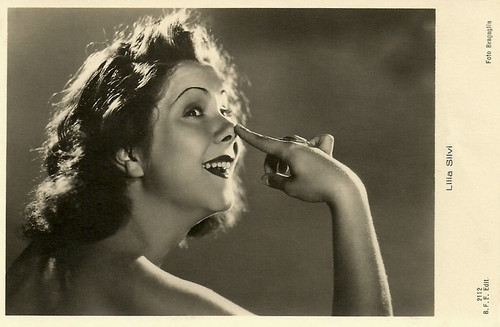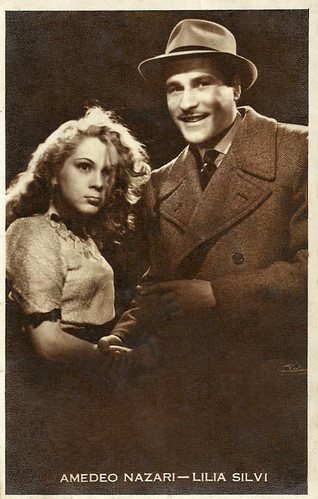Lilia Silvi (1921) was a diva of the Italian Telefoni Bianchi comedies of the 1930's and 1940's, often paired with Amedeo Nazzari. Recently she made a come-back in Gianni e le donne (2011) and the documentary In arte, Lilia Silvi (2011).

Italian postcard by Ballerini & Fratini, Firenze, no. 2112. Photo: Bragaglia.

Italian postcard, no. 62/2. Photo: Lilia Silvi and Roberto Villa in Violette nei capelli/Violets in the hair (Carlo Ludovico Bragaglia, 1942).
Faking a Marriage
Lilia Silvi, originally Silvana Musitelli, was born in Rome, in 1921. After visiting ballet class at the Roman Opera, she had her film debut in Il cantico della terra/La capanna dell'amore/The love shack (1935, Salvatore Fernando Ramponi). She used the pseudonym Alice D'Artena at the time. In Mario Camerini’s famous comedy Il signor Max/Mister Max (1937) she had s small part as an orchid seller, but in the comedy Assenza ingiustificata/Absence Without Leave (1939, Max Neufeld) she had her first major role as the earthquake-like schoolmate of Alida Valli. Soon she became one of the stars of the Italian cinema of the early 1940's. In her subsequent film, the sentimental comedy Scarpe grosse/Big Shoes (1940, Dino Falconi) she had the female lead opposite Amedeo Nazzari, with whom she would be a pair in various films. In Dopo divorzieremo/Later We Will Divorce (1940, Nunzio Malasomma), set in the US, she played a cashier who fakes a marriage with the lover (Nazzari) of her roommate (Vivi Gioi) to help the other two out, but in the end Silvi and Nazzari become a pair. She also played in the Spanish version of this multilingual, now with Maria Mercader and Roberto Rey, and again with Malasomma directing. In 1941 Silvi and Nazzari were paired again in one of the many adaptations of Dario Niccodemi’s Scampolo (1941, Nunzio Malasomma) and in Gianni Franciolini’s comedy Giorni felici/Happy Days (1942).

Italian postcard. Photo: publicity still of Lilia Silvi and Amedeo Nazzari in La bisbetica domata/The Taming of the Shrew (1942).

Italian postcard. Lilia Silvi and Amedeo Nazzarri in Giorni felici/Happy Days (Gianni Franciolini, 1942).
Volcanic
Lilia Skala and Amedeo Nazzari then co-starred in La bisbetica domata/The Taming of the Shrew (1942, Ferdinando Maria Poggioli) a modern version of the classic Shakespearian comedy, situated in a Roman suburb. Nazzari plays the emigrant outsider returning to Italy who tames the volcanic Silvi, whom nobody can control. The film was a hit for both stars. Silvi also sang the title song, La bisbetica domata, which became very popular. She also played opposite Elli Parvo in Arditi civili/Civil Forces (1940, Domenico Gambino), and opposite Sergio Tofano and Andrea Checchi in Giù il sipario/Close the Curtain (1940, Raffaello Matarazzo). Other films were Barbablù/Bluebeard (1941, Carlo Ludovico Bragaglia), and Violette nei capelli/Violets in her hair (1941, Carlo Ludovico Bragaglia) with Roberto Villa. In La vispa Teresa/The sprightly Teresa (1943, Mario Mattoli), Silvi sang Senti il cuore che batte (e come batte!)/Feel How my heart beats (and how it beats). She plays a manicure who substitutes for a colleague (Vera Carmi) who is a ruthless golddigger, hunting for Roberto Villa. Of course Villa prefers Silvi in the end. After Il diavolo in collegio (1944, Jean Boyer) with Leonardo Cortese, Silvi’s career slowed down in the postwar era. She concentrated on theatre and revue instead, playing with Franco Scandurra Franco and Carlo Campanini. She did three more films: Biraghin (1946, Carmine Gallone) with Andrea Checchi, Napoleone/Napoleon (1950, Carlo Borghesio) with Renato Rascel as the French Emperor, and Viva la rivista!/Long live the magazine! (1953, Enzo Trapani). Then she retired from the cinema and dedicated herself to her family. In 1940 Silvi had met and married soccer player Luigi Scarabello, who appeared in her films Violette nei capelli and Barbablù under the pseudonym of Sergio Landi. Scarabello and Silvi had three children, two girls and one boy, and their union lasted a good 67 years until the death of Scarabello in 2007. In 2011 Lilia Silvi made a comeback to the set. After an absence of nearly 50 years, she acted in Gianni Di Gregorio’s comedy Gianni e le donne/The Salt of Life (2011). That same year Mimmo Verdesca made a documentary on her: In arte, Lilia Silvi/In art, Lilia Silvi (2011).
Trailer for In arte, Lilia Silvi (2011). Source: Flabes8 (YouTube).
Sources: Wikipedia (Italian) and IMDb.

Italian postcard by Ballerini & Fratini, Firenze, no. 2112. Photo: Bragaglia.

Italian postcard, no. 62/2. Photo: Lilia Silvi and Roberto Villa in Violette nei capelli/Violets in the hair (Carlo Ludovico Bragaglia, 1942).
Faking a Marriage
Lilia Silvi, originally Silvana Musitelli, was born in Rome, in 1921. After visiting ballet class at the Roman Opera, she had her film debut in Il cantico della terra/La capanna dell'amore/The love shack (1935, Salvatore Fernando Ramponi). She used the pseudonym Alice D'Artena at the time. In Mario Camerini’s famous comedy Il signor Max/Mister Max (1937) she had s small part as an orchid seller, but in the comedy Assenza ingiustificata/Absence Without Leave (1939, Max Neufeld) she had her first major role as the earthquake-like schoolmate of Alida Valli. Soon she became one of the stars of the Italian cinema of the early 1940's. In her subsequent film, the sentimental comedy Scarpe grosse/Big Shoes (1940, Dino Falconi) she had the female lead opposite Amedeo Nazzari, with whom she would be a pair in various films. In Dopo divorzieremo/Later We Will Divorce (1940, Nunzio Malasomma), set in the US, she played a cashier who fakes a marriage with the lover (Nazzari) of her roommate (Vivi Gioi) to help the other two out, but in the end Silvi and Nazzari become a pair. She also played in the Spanish version of this multilingual, now with Maria Mercader and Roberto Rey, and again with Malasomma directing. In 1941 Silvi and Nazzari were paired again in one of the many adaptations of Dario Niccodemi’s Scampolo (1941, Nunzio Malasomma) and in Gianni Franciolini’s comedy Giorni felici/Happy Days (1942).

Italian postcard. Photo: publicity still of Lilia Silvi and Amedeo Nazzari in La bisbetica domata/The Taming of the Shrew (1942).

Italian postcard. Lilia Silvi and Amedeo Nazzarri in Giorni felici/Happy Days (Gianni Franciolini, 1942).
Volcanic
Lilia Skala and Amedeo Nazzari then co-starred in La bisbetica domata/The Taming of the Shrew (1942, Ferdinando Maria Poggioli) a modern version of the classic Shakespearian comedy, situated in a Roman suburb. Nazzari plays the emigrant outsider returning to Italy who tames the volcanic Silvi, whom nobody can control. The film was a hit for both stars. Silvi also sang the title song, La bisbetica domata, which became very popular. She also played opposite Elli Parvo in Arditi civili/Civil Forces (1940, Domenico Gambino), and opposite Sergio Tofano and Andrea Checchi in Giù il sipario/Close the Curtain (1940, Raffaello Matarazzo). Other films were Barbablù/Bluebeard (1941, Carlo Ludovico Bragaglia), and Violette nei capelli/Violets in her hair (1941, Carlo Ludovico Bragaglia) with Roberto Villa. In La vispa Teresa/The sprightly Teresa (1943, Mario Mattoli), Silvi sang Senti il cuore che batte (e come batte!)/Feel How my heart beats (and how it beats). She plays a manicure who substitutes for a colleague (Vera Carmi) who is a ruthless golddigger, hunting for Roberto Villa. Of course Villa prefers Silvi in the end. After Il diavolo in collegio (1944, Jean Boyer) with Leonardo Cortese, Silvi’s career slowed down in the postwar era. She concentrated on theatre and revue instead, playing with Franco Scandurra Franco and Carlo Campanini. She did three more films: Biraghin (1946, Carmine Gallone) with Andrea Checchi, Napoleone/Napoleon (1950, Carlo Borghesio) with Renato Rascel as the French Emperor, and Viva la rivista!/Long live the magazine! (1953, Enzo Trapani). Then she retired from the cinema and dedicated herself to her family. In 1940 Silvi had met and married soccer player Luigi Scarabello, who appeared in her films Violette nei capelli and Barbablù under the pseudonym of Sergio Landi. Scarabello and Silvi had three children, two girls and one boy, and their union lasted a good 67 years until the death of Scarabello in 2007. In 2011 Lilia Silvi made a comeback to the set. After an absence of nearly 50 years, she acted in Gianni Di Gregorio’s comedy Gianni e le donne/The Salt of Life (2011). That same year Mimmo Verdesca made a documentary on her: In arte, Lilia Silvi/In art, Lilia Silvi (2011).
Trailer for In arte, Lilia Silvi (2011). Source: Flabes8 (YouTube).
Sources: Wikipedia (Italian) and IMDb.
1 comment:
How wonderful, Bob. I enjoyed every word, and I loved every photo. Wonderful. She was such a darling saucy girl! Thank you so much for all the work you put into your posts.
Post a Comment